Updated: March 3, 2023
Differences between Roomba j7+ and s9+ in 30 seconds:
The j7+ has a front-facing camera for obstacle avoidance whereas the Roomba s9+ has a top-mounted camera and no obstacle avoidance. The s9+ has wider brushrolls compared to the j7+’s standard brushrolls. The s9+ is D-shaped for improved corner cleaning whereas the j7+ is round. The s9+ has stronger suction, but the j7+ has a newer, slimmer docking station.
Bottom Line: Get the Roomba j7+ if you have pets and want to avoid accidental messes, get the Roomba s9+ if want a more powerful vacuum and don’t have any pets that might leave unwanted presents on the floor when you’re not home.
That was the short version. Read on to learn more.
Contents
- 1 Differences between Roomba j7+ and s9+ in 30 seconds:
- 2 Introduction
- 3 Difference 1 – Cameras & Avoidance Abilities
- 4 Difference 2 – Brushrolls
- 5 Difference 3 – Shape
- 6 Difference 4 – Suction Power
- 7 Difference 5 – Docking Stations
- 8 Similarity 1 – Both Robot Vacuums Have Smart Navigation and Mapping Abilities
- 9 Similarity 2 – Both Models Are Auto-Emptying
- 10 Similarity 3 – Both have Recharge and Resume
- 11 Similarity 4 – Both can be Instructed to Clean Specific Rooms Only
- 12 Similarity 5 – Both have the “keep out zones” feature
- 13 What about the j7 vs s9?
- 14 Conclusion
Introduction
Roombas are probably the most effective and dependable robot vacuums on the market today. While the premium S9 Series is renowned for being the best there is, the latest J-Series introduces a front-facing camera to avoid messes (💩).
Both vacuums offer Roomba’s typical trademark performance and quality, but a couple key differences can affect your choice. Here, we dive into the differences and similarities between these machines.
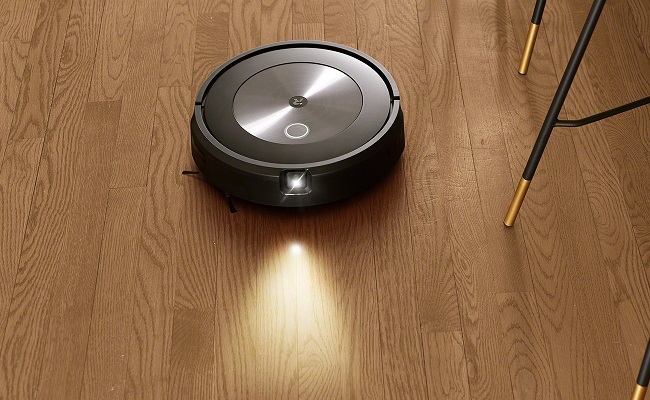
Difference 1 – Cameras & Avoidance Abilities
Only the j7+ has obstacle avoidance, the s9+ does not.
Whether it’s for mapping or obstacle avoidance, cameras are crucial for your robot vacuum to do its job.
The Roomba j7+’s front-facing camera allows it to make use of its obstacle avoidance feature, dodging things like power cords and pet waste. While the s9+ has been designed with a top-mounted camera for a wider field of view, the model does not have obstacle avoidance.
If you have any pets, the Roomba j7+ is the clear choice.
Difference 2 – Brushrolls
Brushrolls matter when it comes to cleaning efficiency. Rubber rollers loosen dirt so they can be easily picked up by the vacuum instead of just pushed around the room. Even though both the j7+ and s9+ are equipped with rubber rollers, they are different in width.
The s9+’s wider brushrolls are more efficient because it requires fewer passes to cover your entire house. The specialized corner-cleaning ability and flat design mean that the s9+ can take care of parts of the room that the j7+ cannot reach as easily, like corners and flat edges.
The j7+’s standard width brushrolls won’t offer the same degree of efficient cleaning that the s9+ offers, but that doesn’t mean the j7+ won’t still deliver good results when it comes to keeping a clean floor.
Difference 3 – Shape
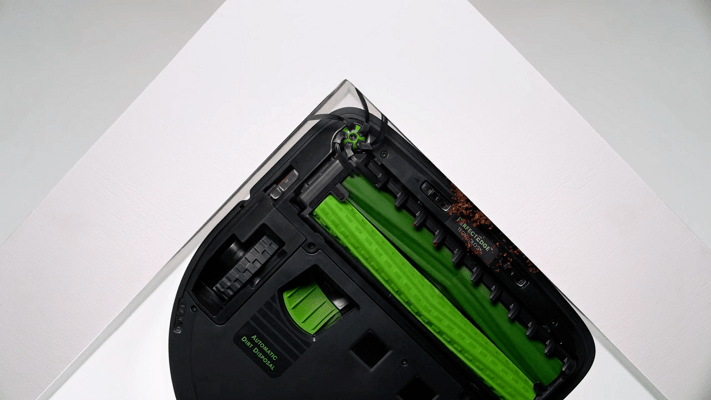
Almost all robot vacuums come with the standard round, low-profile shape. This prevents edges from snagging on obstacles when making turns and allows the vacuum to get in underneath furniture and beds. However, most standard round robot vacuums have more difficulty reaching corners because of their shape.
The s9+’s D-shape solves this problem. With one side of the vacuum flattened, the s9+ can vacuum all the way into a corner easily. This makes it a little more effective than the round j7+.
Difference 4 – Suction Power
The s9+ boasts a much more powerful motor, capable of sucking in everything from cereal to matted pet hair at an impressive 40x suction. The j7+’s 10x suction capacity is not to be ignored, but it pales in comparison to the s9+’s power.
Difference 5 – Docking Stations
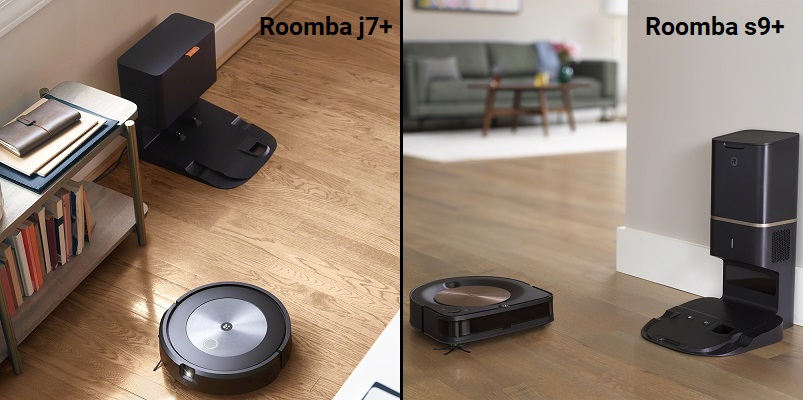
Both of these vacuums return to their docking stations when done cleaning. However, the docking stations (aka home base)are not the same.
The j7+’s home base employs the newer, slimmer design which allows it to be stored in more places than the s9+’s home base. The s9+’s docking station is bulkier and taller, which makes it harder to find a home for.
Even though the s9+’s home base looks bigger than the j7+’s, the two hold the same amount of dust. (They use the same replacement bags.)
Next, let’s look at what these two vacuums have in common.
Both the s9+ and j7+ have the ability to vacuum in straight lines while mapping out your house. Smart navigation means it won’t randomly roam your home like older generation Roombas did. This means clean floors in less time.
Similarity 2 – Both Models Are Auto-Emptying
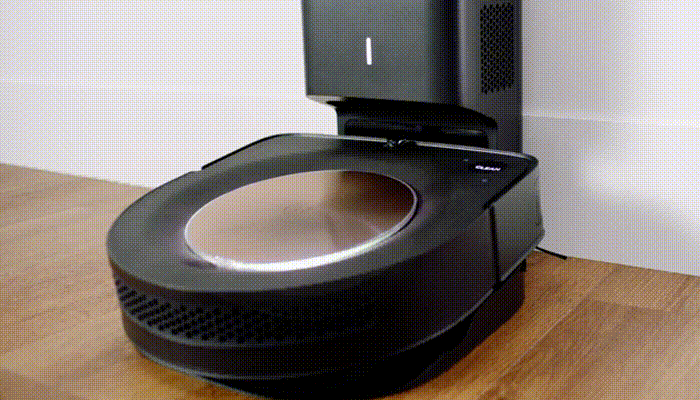
Nobody wants to empty out the dust bin on the robot vacuum every time it finishes cleaning up. Each model’s docking station has a receptacle and sealed bag that lets the cleaners automatically empty whatever they’ve collected. This saves time and takes a tedious step out of your cleaning routine.
Similarity 3 – Both have Recharge and Resume
If you have a large house, these robot vacuums might not be able to vacuum the whole floor in one go. If it thinks it won’t have enough juice to finish the job, it will return to its docking station to recharge before going flat. This allows both the Roomba s9+ and j7+ to resume cleaning as soon as their batteries are charged, meaning an entire story of your house will be vacuumed by the time they are done.
Similarity 4 – Both can be Instructed to Clean Specific Rooms Only
Since both the j7+ and s9+ have advanced mapping, they can also be instructed to only clean certain rooms. After the first couple of runs, these vacuums will learn your floorplan. On subsequent cleanings, you can specify if you only want certain rooms to be vacuumed, and it will follow your instructions and only clean those rooms.
Similarity 5 – Both have the “keep out zones” feature
Both models have the ability to be programmed to avoid certain areas of a room or home. Whether to stay away from sensitive equipment or sleeping family members, both the s9+ and the j7+ allow you to mark off areas of your house you don’t want cleaned. These areas are called “keep out zones” and can be accessed via the iRobot app.
What about the j7 vs s9?
The j7+ and s9+ each have a non-autoemptying version, namely the j7 and s9, respectively. The only difference between the “plus” and “regular” version is the ability to auto-empty the dustbin. The j7 and the s9 come with a standard (and much smaller) charging dock for the machines to return to when it’s done vacuuming. Therefore, all the differences between the “plus” versions also apply to the j7 and s9.
Conclusion
While both of these vacuums are quite capable, each comes with its pros and cons.
The s9+’s D shape and deep cleaning abilities make it a favorite for those who are looking for a powerful, top-of-the-line robot vacuum. While the price is higher than the j7+’s, you’re getting a more powerful machine.
The new Roomba j7+ robot vacuum is iRobot’s first Roomba with a front-facing camera. Capable of recognizing and avoiding different obstacles, this robot vacuum is ideal for pet owners. The standard shape and lack of deep cleaning ability make it a little less potent than the Roomba s9+, but its obstacle (read “poop”) avoidance is a big deal.
So which one should you get? Your specific situation will determine which model is better for you. If money is no object and you don’t have a pet, pick up the s9+. If you have a pet, the j7+ is probably the way to go.
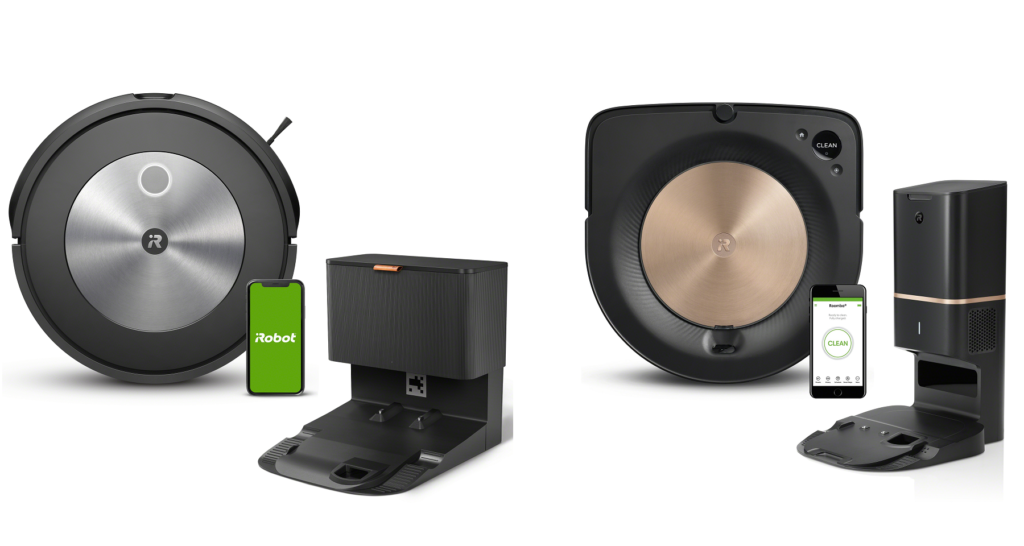
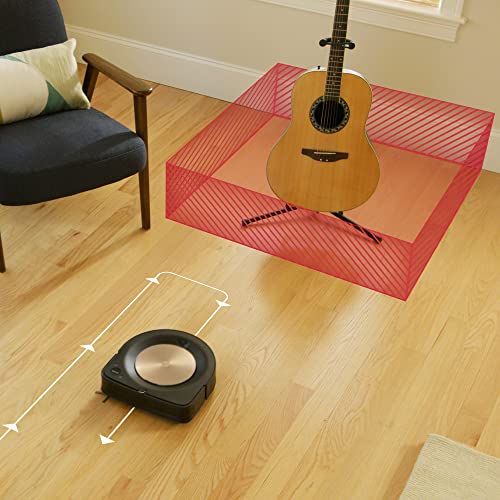


This is the definition of a fair comparison. Succinct, concise and unbiased. If only all reviews could be this good. Thank you, this was very helpful.
Thank you for your kind words Bryan!